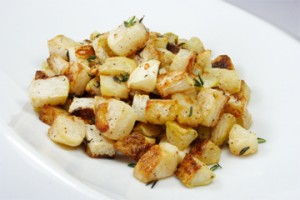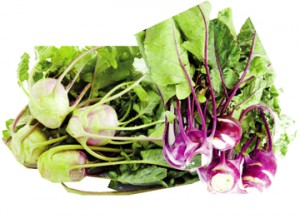By Cynthia Nelson
 Hi Everyone, One of the things that I like about being a food enthusiast, and particularly about visiting agricultural fairs and exhibitions, is the opportunity to discover new produce. That is exactly what happened to me when I visited Barbados’ Agrofest earlier in the year.
Hi Everyone, One of the things that I like about being a food enthusiast, and particularly about visiting agricultural fairs and exhibitions, is the opportunity to discover new produce. That is exactly what happened to me when I visited Barbados’ Agrofest earlier in the year.
I spied this unusual looking vegetable at the booth of Phil Perry, a former teacher turned farmer. There were these bulbs the colours of apple-green and purple and shooting out from them were stems with big beautiful green leaves. In terms of shape, think of a hot air-balloon – the bulb is where the passengers would be and the leaves would be the balloon. When I enquired what they were Mr Perry, answered with the pride only a farmer can have of the fruits of his hard labour: “kohlrabi”. It was the first time I had heard of or seen this vegetable. Mr Perry went on to explain that when he was a student at school they used to plant this vegetable among others as part of their agriculture class. However, to date, it is has not been part of main stream agriculture in Barbados. He’s hoping to grow and make it available to a niche market.
 Kohlrabi gets its name from the German word – kohl meaning cabbage and the Swiss-German variant Rübi – Rabi meaning turnip, the flavour and properties of kohlrabi are very much like that of a cabbage and turnip. The origin of kohlrabi is the same as that of cabbage, broccoli, cauliflower, kale, collard greens and brussel sprouts. Actually as soon as I saw the leaves I thought of kale and collard greens. Though the leaves are edible and can be used pretty much the same way we use spinach, it is the bulbous bottom that is primarily grown for.
Kohlrabi gets its name from the German word – kohl meaning cabbage and the Swiss-German variant Rübi – Rabi meaning turnip, the flavour and properties of kohlrabi are very much like that of a cabbage and turnip. The origin of kohlrabi is the same as that of cabbage, broccoli, cauliflower, kale, collard greens and brussel sprouts. Actually as soon as I saw the leaves I thought of kale and collard greens. Though the leaves are edible and can be used pretty much the same way we use spinach, it is the bulbous bottom that is primarily grown for.
There are several varieties but the ones most popular are the White Vienna and the Purple Vienna (think green cabbage, purple cabbage). In terms of use, kohlrabi can be cooked in a stew, steamed, roasted, sliced and dressed like a salad, stir-fried, grated for a coleslaw; it therefore can be eaten raw and cooked.
When it comes to taste, I find it generally bland, however, depending on how it is prepared, it can produce some very pleasant notes. For example, eaten raw, just as is without a dressing, there is crisp coolness and an ever slight hint of peppery-ness such as in a radish. When shaved or sliced thin and dressed with salt, freshly ground black pepper, good olive oil and lemon juice, the kohlrabi absorbs it all, gets cured and still retains a bite to it. And that is one of the things that I like about kohlrabi, it offers itself as a flavour absorber.
When I roasted some with olive oil, garlic and fresh thyme, it not only absorbed the flavours but there was a sweetness to it once roasted. The outside caramelized and the inside was tender. The next thing I did was to make a dhal with it following a recipe I found on the internet. Cut into chunks, I liked how the kohlrabi bulked up the dhal, so much so that instead of eating the dhal like I generally do with rice or roti, I ate it as a soup; the morsels of sweet tender kohlrabi making every spoonful delightfully filling.
 From a nutrition standpoint, I was happy to read that kohlrabi is low in calories and high in dietary fibre and Vitamin C. How can anyone go wrong with such a vegetable or with any vegetable for that matter?
From a nutrition standpoint, I was happy to read that kohlrabi is low in calories and high in dietary fibre and Vitamin C. How can anyone go wrong with such a vegetable or with any vegetable for that matter?
So in keeping with the theme from last week: taste the difference, I invite you to take an interest in new produce you find whether in a supermarket or in a traditional farmers’ market. I think the next time I get some kohlrabi, I am going to curry it, I’m sure it would be pretty much like curried squash (bottle gourd).
Happy Independence everybody!




